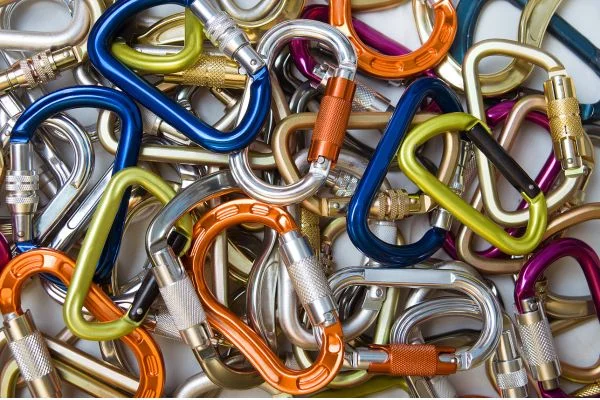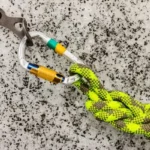Carabiners are one of those items that you see often but never give a second thought to. Of course, you can use it in climbing, but they’re also helpful for various other activities. So let’s take a look at what are carabiners used for.
What Are Carabiners?
Carabiners are metal loops with spring-loaded gates that open and close to connect ropes, harnesses, and other items quickly. They’re usually made from aluminum alloy or steel, making them strong enough to hold up under pressure. The most common types of carabiners are:

- Straight gates (the most versatile kind).
- Bent gates (Especially for quick clipping).
- Locking mechanisms (which keep the gate shut).
Other Types of Carabiners
Carabiners, essential tools in various activities such as rock climbing, hiking, and camping, come in a range of types, each is for specific purposes. These versatile devices enable secure connections, ensuring safety and convenience. Let’s delve into the different types of carabiners and their respective applications:
Standard Carabiners:
They’re like your go-to clip for quickly attaching stuff. The cool thing is, you can open and close them with just one hand. So, whether you’re hooking up ropes to harnesses or gear to your backpack, these carabiners are there for you.
Locking Carabiners:
Picture this: you’re hanging off a cliff, and the last thing you want is for your carabiner to randomly open up. That’s where locking carabiners come in. They’ve got a nifty mechanism to make sure the gate stays shut. Some twist to lock, others do it automatically. These are the safety pros for serious stuff like anchoring and creating solid connections in climbing systems.
D-shaped Carabiners:
They look like the letter “D”. Because of their shape, they’re super strong and perfect for anchor systems and rigging. They spread the load out nicely, which is just what you need when things get heavy-duty.
Oval Carabiners:
Imagine a carabiner that’s like, “I’m good with any rope size.” That’s the oval carabiner. It’s not as strong as the D-shaped ones, but it’s got a bigger gate opening. That means you can hook it up to all sorts of anchor points. These are the go-to pals for big wall climbing and industrial tasks.
Pear/HMS Carabiners:
These carabiners are like the accommodating hosts of the bunch. They’re wider at the top, so they can handle different rope sizes and knots. That makes them perfect for situations where you need to belay using something like a Munter hitch. Think emergency rappelling and quick belaying.
Wiregate Carabiners:
These are like the lightweight champs. Instead of a solid gate, they’ve got this cool loop of wire. That keeps them light and nimble, which is awesome for trad climbing and alpine adventures. Plus, they don’t flap around like crazy when things get wild.
Bent Gate Carabiners:
You know those moments when you need to clip in really fast? That’s where bent gate carabiners shine. They’ve got this bent shape that gives you a bigger opening to slide your rope or gear into. Perfect for those times when speed is the name of the game.
Keylock Carabiners:
Keylock carabiners are like the anti-snag superheroes. They’ve got this special design that keeps them from catching on ropes or gear when you’re clipping and unclipping. If you’re into aid climbing or setting up quickdraws, these are your best friends.
Auto-locking Carabiners:
Think of these as the hands-free carabiners. They automatically lock when you release them. That’s a huge deal in situations where you need both hands for other stuff, like rescue operations or industrial work.
Why Are They Called Carabiners?
Have you ever wondered why we use carabiners the way they are? It’s a pretty exciting story! The name “carabiner” comes from the German word “Karabinerhaken,” which translates to “carbine hook.” This is because these metal devices were first invented in late 18th century Europe by mountaineering clubs and were mainly famous among military forces as connecting links for their rifles and other equipment – hence, the term ‘carbine.’

Over time, as carabiner technology advanced and more recreational uses for them began taking shape, the name stuck. However, everyone now associates them mainly with rock climbing or other outdoor activities. To this day, though, it’s probably still best practice to think twice before using one of these heavy-duty hooks as an actual ammunition holder.
What Were Carabiners Initially Used For?
You should know what are carabiners used for. They have been around since the early 20th century, but they only became popular once mountaineers used them in the 1960s. Originating in Germany and Austria, they are a secure way to attach a piece of equipment or clothing to a belt loop.
Since then, their use is increasing dramatically and many people use it now in many different contexts. They are available on backpacks, belts, and clotheslines – in addition to other applications related to recreation activities such as rock climbing and camping. It’s incredible how these simple metal clips have become such an essential part of everyday life!
What Were Carabiners Used For In the 20s?
They are for rock climbers looking for an easier way to attach themselves to their harnesses without having to tie knots in the ropes. Since then, they have become popular among campers and hikers who use them for attaching equipment like lanterns and water bottles to their packs or belts. But carabiners aren’t just limited to outdoor activities; some even use them as keychains or holders in their homes!
In addition to being incredibly versatile, carabiners are also solid – some models can hold up to 5,000 pounds! This makes them ideal for activities like rappelling, where you need something that can withstand a lot of force while still being lightweight and easy to carry around. Plus, if your carabiner damages, you can easily replace it with another one without buying entirely new gear.
What is a Carabiner Used For In Rock Climbing?
Rock climbers rely on carabiners’ muscular strength and dependability when navigating routes. You can use it to clip into a climbing rope and are incredibly versatile. Simply attaching a carabiner to an anchor, like a quickdraw or a piece of climbing equipment, it is much easier for rock climbers to safely ascend higher up the wall and protect themselves from falls. Some experienced climbers even carry multiple carabiners along their journey to quickly access one when you need. The great thing about carabiners is that they come in various sizes, shapes, and colors so that rock climbers can use them in many different ways during their ascent.
Conclusion:
Now you have a clear concept about what are carabiners used for. Whether you’re an experienced climber looking for a convenient way to attach your gear or just someone looking for an exciting conversation starter on your keychain –carabiners offer a wide range of uses that make them invaluable tools in any toolbox! With so many different sizes and styles available, there’s sure to be a carabineer perfect for whatever activity you plan on doing next! So go ahead and explore the possibilities –you won’t regret it!



